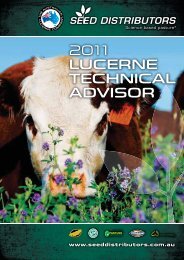Lentil variety sowing guide 2012 - Seed Distributors
Lentil variety sowing guide 2012 - Seed Distributors
Lentil variety sowing guide 2012 - Seed Distributors
Create successful ePaper yourself
Turn your PDF publications into a flip-book with our unique Google optimized e-Paper software.
where CCN or SN is a problem.<br />
There are now twelve varieties resistant<br />
to CCN (Table 5) and nine of these are<br />
also tolerant: Wombat, Tammar, Mulgara,<br />
Tungoo, Kangaroo, Wintaroo, Marloo,<br />
Wallaroo and Potoroo are all varieties<br />
with both CCN resistance and tolerance.<br />
The remaining three resistant varieties,<br />
Yallara, Brusher and Euro are intolerant.<br />
There are eight varieties tolerant to stem<br />
nematode. These are Wombat, Tammar,<br />
Mulgara, Tungoo, Wintaroo, Glider,<br />
Quoll and Echidna.<br />
All of these are rated as resistant<br />
or moderately resistant to SN except<br />
Echidna which is rated as moderately<br />
susceptible. Kangaroo, Potoroo, Marloo<br />
and Wallaroo are intermediate in their<br />
reaction to SN. In cold wet seasonal<br />
conditions these varieties may suffer<br />
more yield loss than in warmer, drier<br />
winter conditions.<br />
Is leaf disease a production<br />
constraint?<br />
Resistance to leaf diseases is important<br />
in most environments. However, even<br />
though varieties are listed as resistant<br />
to stem and leaf rust, changes in rust<br />
pathotypes can occur. Monitoring of<br />
disease levels and application of fungicide<br />
may still be required. Table 1 should be<br />
used to determine the <strong>variety</strong> options<br />
available for a particular end use. Next,<br />
Table 5 should be used to further refine<br />
your choice.<br />
For example, if a <strong>variety</strong> for oat hay is<br />
required in a high rainfall environment,<br />
Forester, Tammar, Tungoo, Mulgara,<br />
Kangaroo, Brusher, Wintaroo and Glider<br />
are suitable (Table 1). Table 3 indicates<br />
that Wintaroo is the highest yielding<br />
<strong>variety</strong> for hay in this environment.<br />
However, using Table 5 Forester, Tammar,<br />
Tungoo, Mulgara, Kangaroo, Brusher and<br />
Glider have better resistance to both stem<br />
and leaf rust.<br />
These varieties also vary in their level<br />
of resistance to septoria, barley yellow<br />
dwarf virus (BYDV), bacterial blight<br />
and red leather leaf which may be also<br />
be important. Table 4 should then be<br />
used to determine if the <strong>variety</strong> selected<br />
matures at the time required.<br />
Is milling quality required?<br />
The probability of a <strong>variety</strong> meeting the<br />
classification criteria for milling grade<br />
is an important consideration when<br />
selecting a <strong>variety</strong> for milling end-use.<br />
This is greatly influenced by seasonal<br />
Table 2. Seven year (2004-2010) average grain yield of oat varieties tested in grain trials.<br />
Potential yield no. trials<br />
1.0 t/ha 2.5 t/ha 4.0 t/ha<br />
Semi-dwarf (husked)<br />
Echidna 1.0 2.7 4.4 71<br />
Mitika 1.1 2.7 4.3 88<br />
Possum 1.0 2.7 4.3 88<br />
Potoroo 1.1 2.7 4.3 86<br />
Quoll 1.1 2.7 4.4 61<br />
Wombat<br />
Semi-dwarf (naked)<br />
1.0 2.7 4.4 45<br />
Numbat<br />
Tall (husked)<br />
0.7 1.8 2.8 42<br />
Euro 1.0 2.5 4.1 85<br />
Mortlock 0.9 2.2 3.6 70<br />
Yallara 1.0 2.5 4.0 88<br />
Table 3. Six year average hay (2005-2010) and grain (2005-2010) production of oat varieties tested in hay trials<br />
Hay yield (t/ha) Grain yield (t/ha)<br />
Rainfall zone Rainfall zone<br />
500mm 500mm<br />
Brusher 6.1 8.8 13.0 1.8 2.8 3.2<br />
Kangaroo 6.0 8.5 13.4 1.8 2.6 3.1<br />
Mulgara 6.3 8.7 13.5 1.8 2.8 3.1<br />
Tammar 5.9 8.2 14.0 1.8 2.6 3.2<br />
Tungoo 6.2 8.2 13.8 1.5 2.2 2.7<br />
Wallaroo 5.4 8.3 12.1 1.8 2.8 3.1<br />
Wintaroo 6.5 9.3 14.5 1.9 2.9 3.3<br />
Yallara 5.5 8.3 12.2 1.9 2.9 3.4<br />
No. trials 10 25 3 17 30 10<br />
Tall (husked) - late hay trial series<br />
Forester - 6.1 12.9 1.0 1.3 2.0<br />
Glider - 7.8 11.1 1.3 1.9 2.5<br />
No. trials - 6 10 3 11 14<br />
conditions. Premium milling varieties<br />
such as Yallara, Mitika, Possum, Wombat,<br />
Euro and Mortlock, will reach the<br />
classification criteria for milling grade<br />
more often than other varieties such as<br />
Echidna (Table 6).<br />
Although some varieties are not<br />
considered milling class, they may reach<br />
milling grade criteria, but would not be<br />
accepted for milling.<br />
It is imperative that you check with your<br />
miller about the quality standards and<br />
varieties that are accepted for milling<br />
before you sow a grain crop.<br />
To select a <strong>variety</strong> for milling grain in<br />
medium to high rainfall zones where<br />
CCN is not a problem, you have the<br />
choice of Yallara, Mitika, Possum, Euro,<br />
Echidna and Mortlock (Table 1). Table<br />
2 shows the relative yield and Table 6 the<br />
relative grain quality for each of these<br />
varieties. Using this information, choose<br />
a <strong>variety</strong> that suits your end use based<br />
on whether yield or quality is a priority.<br />
Table 4 should also be used to determine<br />
if the <strong>variety</strong> selected matures at the time<br />
required. For the first time there is a<br />
choice for milling grain where CCN is a<br />
problem.<br />
If export hay quality is required<br />
Hay quality is essential to meet export<br />
hay standards. It is greatly influenced<br />
by seasonal and nutritional conditions,<br />
however, some varieties are more likely<br />
to produce hay of a higher quality than<br />
others.<br />
It is imperative that you check with your<br />
hay processor about the quality standards<br />
required to make export grade quality<br />
hay before you sow a hay crop. Use Table<br />
7 to refine your choice after first ensuring<br />
35




